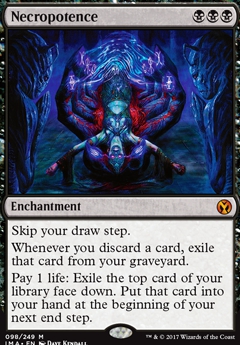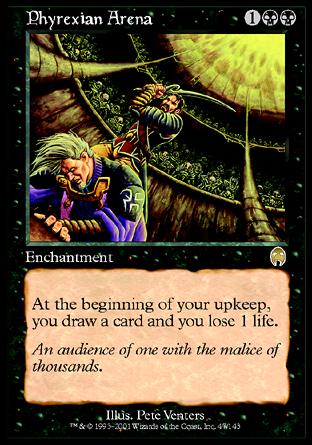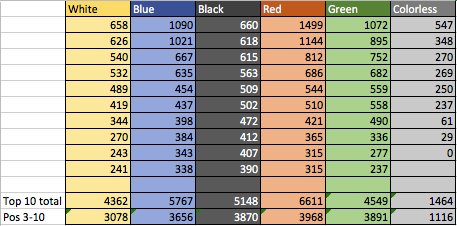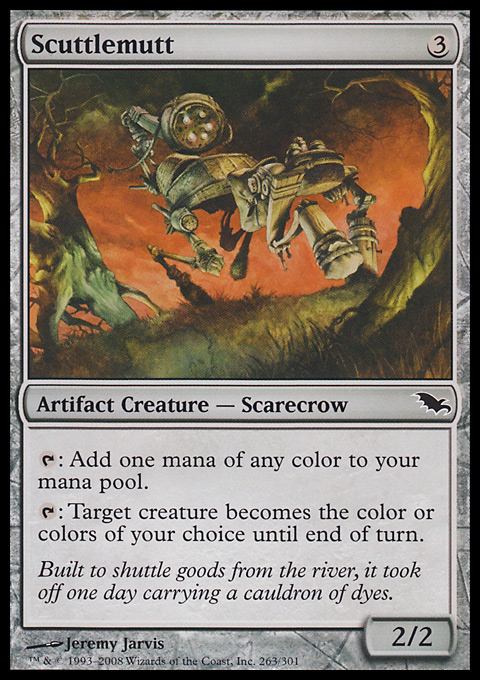Welcome back, dear readers! Today, since we've had two weeks of five-colored decks, we're taking a step back from rainbow manabases and instead we're going to focus on but a single color: black. Our patient is reader Sara's Horobi, Death's WailHorobi, Death's Wail deck. Before we get into it, however, we should discuss the broader perspectives.
Mono-colored Decks in EDH
While I tend to prefer to play two or three colors in my own decks, I have played many mono-colored builds in my time within the format. Mono-black is, in my opinion and in a vacuum, the single most powerful out of the six options (counting colorless), because black has a few things going for it that other colors would give an arm and a leg for: it has the single most powerful tutors in the format in Demonic TutorDemonic Tutor and Vampiric TutorVampiric Tutor, but even cards like Beseech the QueenBeseech the Queen could very well find their way into mono-black lists. I like using the latter to fetch Cabal CoffersCabal Coffers. The reveal clause is sometimes an issue, but it hardly ever truly matters.
Secondly, black has arguably the second best card draw in the format, after blue. Green also has a few very powerful card draw spells, but while green often has to rely on a creature to assist with these spells – in the veins of Rishkar's ExpertiseRishkar's Expertise etc. – black can use mana and life instead. NecropotenceNecropotence, Phyrexian ArenaPhyrexian Arena, Read the BonesRead the Bones, Skeletal ScryingSkeletal Scrying, the list goes on, and all of these spells are very much worth both the mana and the life, especially considering we're in a multiplayer format with 40 life.



Finally, black has the ability to be very explosive in their ramp when alone. Cabal CoffersCabal Coffers is a powerful format staple, and there's no shortage of playable mana rocks in mono-black with Jet MedallionJet Medallion, Wayfarer's BaubleWayfarer's Bauble, Sol RingSol Ring, Mind StoneMind Stone, Worn PowerstoneWorn Powerstone, and so on being often adequate replacements for green-like ramp that fetches lands to put into play.
All of this must also be considered in light of the fact that black is designed to be played by itself in ways that other colors simply aren't. It's part of black's color philosophy to urge players to add more black into any decks running it. This means that black gets cards like Nightmare LashNightmare Lash, MutilateMutilate, Gray Merchant of AsphodelGray Merchant of Asphodel, and the aforementioned Cabal CoffersCabal Coffers, all of these format staples for very good reasons.
Looking at EDHREC, we can see a few very interesting things about mono-colored decks. The single most popular mono-colored commander is neither black nor blue, but red: Krenko, Mob BossKrenko, Mob Boss has a staggering 1,499 decks to his name registered on the site. Following him is Talrand, Sky SummonerTalrand, Sky Summoner with 1,090 decks, and then Omnath, Locus of ManaOmnath, Locus of Mana at 1,072. Way further down the list is the most popular mono-black commander, Ghoulcaller GisaGhoulcaller Gisa at 660 decks to her name. I've counted up all the top ten commanders for each color, and compared both the total number of decks and the total number when disregarding the top two positions, in order to both regard and disregard the enormously popular single commanders in red, blue, and green.

Notice how the numbers tend to even out if we disregard the top two positions, and the number one color to play by itself, red, is still ahead of the competition, but not by a lot. Green and black are on par, while blue finds itself in position four. The conclusion thus is that while black lacks the super popular single commander a la Azami, Lady of ScrollsAzami, Lady of Scrolls, it has a more evenly distributed popularity, with many viable choices. mono-black clearly is no slouch.
Building Around Your Commander
Horobi, Death's WailHorobi, Death's Wail is a very interesting commander. It gives the “skulking” ability to every creature on the board, meaning everything that targets turns into straight removal. This is very powerful, and we should have this ability in mind every step of the way when constructing our deck.
The prospect of making the commander the focal point of the deck used to be a lot scarier than it is today. Before the removal of the infamous “tuck” rule in March of 2015, the best-laid plans in any deck could be disrupted via a well-timed HinderHinder, OblationOblation, or Chaos WarpChaos Warp to name a few. These spells were everywhere and if your commander ended up on the bottom of your library, you'd have to tutor it up again or face the rest of the game without it.



The removal of this rule was controversial in the community, with good reason. Tucking was a powerful response to decks like Purphoros, God of the ForgePurphoros, God of the Forge and other commander-centric themes. That said, I was never a fan of the tuck rule, because it seemed to go against the spirit and flavor of the format, in my opinion. The rule's removal makes it a lot safer to build around your commander, and I think that is intrinsically a good thing. When I brew, I almost always find an interesting commander first, rather than a color or mix thereof, a certain theme or strategy, a combo, or anything else that can be brewed around. It is of course absolutely fine to brew an EDH deck like any other deck and just pick a commander for the color(s) it provides, but that isn't my style.
Here we have a patient that is full-on mono-black and a deck very much centered around the commander itself.
Establishing a Diagnosis
I should note that the name of the deck was the name of the list sent in by Sara. I don't want to be harsh right from the get-go.
Horobi Jankness
View on ArchidektCommander (1)
- 1 Horobi, Death's WailHorobi, Death's Wail
Artifacts (17)
- 1 Bontu's MonumentBontu's Monument
- 1 Caged SunCaged Sun
- 1 Cauldron of SoulsCauldron of Souls
- 1 Distorting LensDistorting Lens
- 1 Glaring SpotlightGlaring Spotlight
- 1 Hero's BladeHero's Blade
- 1 Jet MedallionJet Medallion
- 1 Liquimetal CoatingLiquimetal Coating
- 1 Nihil SpellbombNihil Spellbomb
- 1 Scale of Chiss-GoriaScale of Chiss-Goria
- 1 Sol RingSol Ring
- 1 Spine of Ish SahSpine of Ish Sah
- 1 Squee's ToySquee's Toy
- 1 Staff of NinStaff of Nin
- 1 Tooth of Chiss-GoriaTooth of Chiss-Goria
- 1 Veilstone AmuletVeilstone Amulet
- 1 Thaumatic Compass[/Artifacts]Thaumatic Compass[/Artifacts]
Creatures (23)
- 1 Archetype of FinalityArchetype of Finality
- 1 Bloodgift DemonBloodgift Demon
- 1 Crypt GhastCrypt Ghast
- 1 Festering NewtFestering Newt
- 1 Harvester of SoulsHarvester of Souls
- 1 Hell's CaretakerHell's Caretaker
- 1 Hex ParasiteHex Parasite
- 1 Karn, Silver GolemKarn, Silver Golem
- 1 Kokusho, the Evening StarKokusho, the Evening Star
- 1 Merciless ExecutionerMerciless Executioner
- 1 MortivoreMortivore
- 1 Nezumi GraverobberNezumi Graverobber
- 1 NightmareNightmare
- 1 Ob Nixilis, the FallenOb Nixilis, the Fallen
- 1 Phyrexian ObliteratorPhyrexian Obliterator
- 1 Royal AssassinRoyal Assassin
- 1 Sepulchral PrimordialSepulchral Primordial
- 1 Skittering HeartstopperSkittering Heartstopper
- 1 Solemn SimulacrumSolemn Simulacrum
- 1 Tetzimoc, Primal DeathTetzimoc, Primal Death
- 1 Twilight ProphetTwilight Prophet
- 1 Vindictive LichVindictive Lich
- 1 Liliana, Heretical HealerLiliana, Heretical Healer
Enchantments (4)
- 1 Black MarketBlack Market
- 1 Phyrexian ReclamationPhyrexian Reclamation
- 1 Retreat to HagraRetreat to Hagra
- 1 Retribution of the AncientsRetribution of the Ancients
Instants (9)
- 1 Aphotic WispsAphotic Wisps
- 1 CremateCremate
- 1 DisfigureDisfigure
- 1 Fated ReturnFated Return
- 1 Scour from ExistenceScour from Existence
- 1 Seize the SoulSeize the Soul
- 1 Touch of DarknessTouch of Darkness
- 1 Tragic SlipTragic Slip
- 1 Vona's Hunger[/Instants]Vona's Hunger[/Instants]
Planeswalkers (1)
- 1 Liliana of the Dark RealmsLiliana of the Dark Realms
Sorceries (11)
- 1 Ambition's CostAmbition's Cost
- 1 Ancient CravingAncient Craving
- 1 Decree of PainDecree of Pain
- 1 Mind SludgeMind Sludge
- 1 MutilateMutilate
- 1 Night's WhisperNight's Whisper
- 1 PoxPox
- 1 Resourceful ReturnResourceful Return
- 1 Ruinous PathRuinous Path
- 1 Torment of HailfireTorment of Hailfire
- 1 VictimizeVictimize
Lands (34)
- 1 Arcane LighthouseArcane Lighthouse
- 1 Bojuka BogBojuka Bog
- 1 DesertDesert
- 1 Leechridden SwampLeechridden Swamp
- 1 Mortuary MireMortuary Mire
- 1 Myriad LandscapeMyriad Landscape
- 27 SwampSwamp
- 1 Temple of the False GodTemple of the False God
Link to the deck on Deckstats: Click!
At a first glance, this is a functional deck that has a solid game plan for at least the first few stages of the game. In essence, we want to play lands and ramp for a few turns, and then establish board dominance through Horobi, Death's WailHorobi, Death's Wail's static ability which effectively renders any non-hexproof, non-shroud creatures moot, provided we have a way to target them. It's easy to think that all we have to do then is to start swinging in, but Horobi turns our own creatures into papier-mâché-armored weaklings as well, meaning we could use some sort of resilience to other people's targeted things, as well as more ways to effectively end the game. We're also a bit lacking in ramp, and also in pure card-draw, both of these issues will be resolved, and we're missing some lands. Lastly, the mana curve is a bit all over the place, and we'll try to fix that as well, which will be helped by adding more lands as well.
Cutting Into the Patient
With these issues in mind, I've arrived at the following suggestions, looking a lot at EDHREC's suggestions:
Changes
View on ArchidektOUT (14)
- 1 Archetype of FinalityArchetype of Finality
- 1 Festering NewtFestering Newt
- 1 NightmareNightmare
- 1 Ob Nixilis, the FallenOb Nixilis, the Fallen
- 1 Phyrexian ObliteratorPhyrexian Obliterator
- 1 Royal AssassinRoyal Assassin
- 1 Skittering HeartstopperSkittering Heartstopper
- 1 Scour from ExistanceScour from Existance
- 1 CremateCremate
- 1 Seize the SoulSeize the Soul
- 1 Resourceful ReturnResourceful Return
- 1 Spine of Ish SahSpine of Ish Sah
- 1 Night's WhisperNight's Whisper
- 1 Pox[/OUT]Pox[/OUT]
IN (14)
- 1 Cabal StrongholdCabal Stronghold
- 1 Tower of the MagistrateTower of the Magistrate
- 1 SwampSwamp
- 1 Phyrexian ArenaPhyrexian Arena
- 1 Read the BonesRead the Bones
- 1 Skeletal ScryingSkeletal Scrying
- 1 Wretched ConfluenceWretched Confluence
- 1 ScuttlemuttScuttlemutt
- 1 Mimic VatMimic Vat
- 1 Gray Merchant of AsphodelGray Merchant of Asphodel
- 1 Profane CommandProfane Command
- 1 Yahenni, Undying PartisanYahenni, Undying Partisan
- 1 Mirage MirrorMirage Mirror
- 1 ExsanguinateExsanguinate
Other options (5)
- 1 Cabal CoffersCabal Coffers
- 1 Urborg, Tomb of YawgmothUrborg, Tomb of Yawgmoth
- 1 Nykthos, Shrine to NyxNykthos, Shrine to Nyx
- 1 UrborgUrborg
- 1 Command BeaconCommand Beacon
I've chosen to remove some of the cards that are objectively powerful — Ob Nixilis, the FallenOb Nixilis, the Fallen and Phyrexian ObliteratorPhyrexian Obliterator to name two - but don't really fit into the deck's theme. NightmareNightmare is pretty awesome, but not very powerful, while Night's WhisperNight's Whisper is a perfectly fine card, I cut it for Read the BonesRead the Bones. Cabal CoffersCabal Coffers is unfortunately very expensive for an uncommon, and so is Urborg, Tomb of YawgmothUrborg, Tomb of Yawgmoth. Dominaria however is soon out with the pretty awesome Cabal StrongholdCabal Stronghold, who can service well in the deck. Tower of the MagistrateTower of the Magistrate works with our commander, and can also screw over equipment-heavy decks even without the commander on the board. Phyrexian ArenaPhyrexian Arena, Read the BonesRead the Bones, Skeletal ScryingSkeletal Scrying, and Wretched ConfluenceWretched Confluence are all great card-draw and the latter serves the deck well with all functions, especially Horobi, Death's WailHorobi, Death's Wail on the board. ScuttlemuttScuttlemutt is hilarious in that it's both a mana rock and an Avatar of WoeAvatar of Woe rolled into one in this deck. Mimic VatMimic Vat is one of my pet cards and fantastic seeing as how we're killing a lot of creatures on all sides, and it can be combined with Gray Merchant of AsphodelGray Merchant of Asphodel for pretty disgusting results. Profane CommandProfane Command is a silly goodstuff card in all mono-black decks, but it becomes even more ridiculous with Horobi because the fear-granting mode can kill several creatures, and Yahenni, Undying PartisanYahenni, Undying Partisan is another sacrifice outlet for when we want to turn off our commander, and he also dodges the drawback of having Horobi, Death's WailHorobi, Death's Wail on the field by making himself indestructable. Lastly, Mirage MirrorMirage Mirror is often fantastic on its own, and plain hilarious with the commander in play, and ExsanguinateExsanguinate is another win con for when board dominance is assured, and it's another spell to pump all the mana from Black MarketBlack Market, Cabal StrongholdCabal Stronghold and our mana doublers into.



Under "Other options" I've included a list of the more expensive lands that might not be auto-includes if you're on a budget, but they are all good in the deck. Especially UrborgUrborg is hilarious in that it's almost a basic Swamp that doubles as "Tap: Destroy target creature with our commander on the field. It dodges most types of protection aside shroud and hexproof, and it's got a nice "No, not that Urborg, this UrborgUrborg!" feel which is likely to cause some interesting looks around the table.
The Final Iteration
The changes above leaves us with this list:
Horobi Is Not Jank
View on ArchidektCommander (1)
- 1 Horobi, Death's WailHorobi, Death's Wail
Artifacts (93)
- 1 Bontu's MonumentBontu's Monument
- 1 Caged SunCaged Sun
- 1 Cauldron of SoulsCauldron of Souls
- 1 Distorting LensDistorting Lens
- 1 Glaring SpotlightGlaring Spotlight
- 1 Hero's BladeHero's Blade
- 1 Jet MedallionJet Medallion
- 1 Liquimetal CoatingLiquimetal Coating
- 1 Mimic VatMimic Vat
- 1 Mirage MirrorMirage Mirror
- 1 Nihil SpellbombNihil Spellbomb
- 1 Scale of Chiss-GoriaScale of Chiss-Goria
- 1 Sol RingSol Ring
- 1 Squee's ToySquee's Toy
- 1 Staff of NinStaff of Nin
- 1 Tooth of Chiss-GoriaTooth of Chiss-Goria
- 1 Veilstone AmuletVeilstone Amulet
- 1 Thaumatic Compass[/Artifacts][Creatures]*1 Bloodgift DemonThaumatic Compass[/Artifacts][Creatures]*1 Bloodgift Demon
- 1 Crypt GhastCrypt Ghast
- 1 Gray Merchant of AsphodelGray Merchant of Asphodel
- 1 Harvester of SoulsHarvester of Souls
- 1 Hell's CaretakerHell's Caretaker
- 1 Hex ParasiteHex Parasite
- 1 Karn, Silver GolemKarn, Silver Golem
- 1 Kokusho, the Evening StarKokusho, the Evening Star
- 1 Liliana, Heretical HealerLiliana, Heretical Healer
- 1 Merciless ExecutionerMerciless Executioner
- 1 MortivoreMortivore
- 1 Nezumi GraverobberNezumi Graverobber
- 1 ScuttlemuttScuttlemutt
- 1 Sepulchral PrimordialSepulchral Primordial
- 1 Solemn SimulacrumSolemn Simulacrum
- 1 Tetzimoc, Primal DeathTetzimoc, Primal Death
- 1 Twilight ProphetTwilight Prophet
- 1 Vindictive LichVindictive Lich
- 1 Yahenni, Undying Partisan[/Creatures][Enchantments]*1 Black MarketYahenni, Undying Partisan[/Creatures][Enchantments]*1 Black Market
- 1 Phyrexian ArenaPhyrexian Arena
- 1 Phyrexian ReclamationPhyrexian Reclamation
- 1 Retreat to HagraRetreat to Hagra
- 1 Retribution of the Ancients[/Enchantments][Instants]*1 Aphotic WispsRetribution of the Ancients[/Enchantments][Instants]*1 Aphotic Wisps
- 1 DisfigureDisfigure
- 1 Fated ReturnFated Return
- 1 Skeletal ScryingSkeletal Scrying
- 1 Touch of DarknessTouch of Darkness
- 1 Tragic SlipTragic Slip
- 1 Vona's HungerVona's Hunger
- 1 Wretched Confluence[/Instants][Planeswalkers]*1 Liliana of the Dark Realms[/Planeswalkers][Sorceries]*1 Ambition's CostWretched Confluence[/Instants][Planeswalkers]*1 Liliana of the Dark Realms[/Planeswalkers][Sorceries]*1 Ambition's Cost
- 1 Ancient CravingAncient Craving
- 1 Decree of PainDecree of Pain
- 1 ExsanguinateExsanguinate
- 1 Mind SludgeMind Sludge
- 1 MutilateMutilate
- 1 Profane CommandProfane Command
- 1 Read the BonesRead the Bones
- 1 Ruinous PathRuinous Path
- 1 Torment of HailfireTorment of Hailfire
- 1 Victimize[/Sorceries][Lands]*1 Arcane LighthouseVictimize[/Sorceries][Lands]*1 Arcane Lighthouse
- 1 Bojuka BogBojuka Bog
- 1 Cabal StrongholdCabal Stronghold
- 1 DesertDesert
- 1 Leechridden SwampLeechridden Swamp
- 1 Mortuary MireMortuary Mire
- 1 Myriad LandscapeMyriad Landscape
- 28 SwampSwamp
- 1 Temple of the False GodTemple of the False God
- 1 Tower of the Magistrate[/Lands]Tower of the Magistrate[/Lands]
Link to the deck on Deckstats.net: Click!
What's left is a more focused, a bit more tuned deck list that operates smoother than it did before. The curve is a bit better, still with an emphasis on the one-drops, but with more three-drops and fewer spells at four mana or higher. This should reduce the number of awkward hands that has distributions like two lands, a one drop, a two drop, and three four drops - we all know how tempting it might be to keep those, but if you don't draw land in the first couple of turns, you're probably out of luck.
I hope Sara is happy with my take on her list, and I hope that you, dear reader, have enjoyed the article as well. Do you think I missed any cards in my take? Leave a comment below, and help Sara find even more awesome cards for her deck!
Do You Want Your Deck Featured Here?
General Medicine is a bi-weekly column where I take a look at your EDH deck, run it through our own EDHREC analysis, add some twists and turns of my own, and present your deck with an analysis for the world to see, right here on this site! Sounds exciting? Want your sweet brew featured (as in, picked apart, analyzed, and written about – it's not as scary as it might sound!) in my series?
Here's what you do:
- Send an e-mail to edhrecdecksubmissions@gmail.com and make sure you include the following:
- An easy to read decklist. Links to the usual suspects (TappedOut, Deckstats, etc.) is fine.
- A short description of your deck – how does it play? How does it win? What are your favorite cards?
- A short description of where you want to go with the deck – is it competitive? 75%? Casual?
- If needed, a short description of your local metagame – are there any decks you're looking to beat?
- Sign it with your name, but let me know if you want to remain anonymous or use an alias.
- Hold on to your Krark's Thumb and hope that I will choose your deck!
- The series will premiere at the earliest in March, but the e-mail is open for submissions now! The more time I have to analyze your deck, the likelier it is that I will choose it! So get your submissions in now!
I am not using some sort of first-come, first-served policy, I am choosing the most interesting deck, and I am also looking at the best write-ups! Make sure you read the submission guidelines above, and take your time when writing me your e-mail; the better the write-up, the higher the chance I pick your deck! And if you're not picked next time, fear not – I will be keeping any unused lists and write-ups in my log, from which I will pull the nuggets every other week.
Robin Kaas
Robin started playing Magic in secondary school, around Urza block, and has spent his entire time in the game with non-rotating formats. In his past, Robin was a diehard competitive tournament player, but he has shifted to playing EDH/Commander and Limited almost exclusively in the past years. He works as a development manarger in charge of democracy development, and lives in Sweden with his wife and his daughter.
Your opinions are welcome. We love hearing what you think about Magic! We ask that you are always respectful when commenting. Please keep in mind how your comments could be interpreted by others. Personal attacks on our writers or other commenters will not be tolerated. Your comments may be removed if your language could be interpreted as aggressive or disrespectful. You may also be banned from writing further comments.
